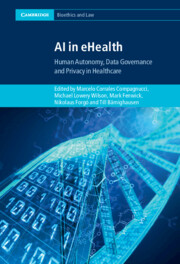Book contents
- AI in eHealth
- Cambridge Bioethics and Law
- AI in eHealth
- Copyright page
- Contents
- Contributors
- Preface
- Acronyms
- 1 Mapping the Digital Healthcare Revolution
- Part I Platforms, Apps and Digital Health
- Part II Trust and Design
- Part III Knowledge, Risk and Control
- Part IV Balancing Regulation, Innovation and Ethics
- 11 Doctors Without Borders? The Law Applicable to Cross-Border eHealth Services and AI-Based Medicine
- 12 Organisational Readiness for the Adoption of Artificial Intelligence in Hospitals
- 13 Regulating the ‘Benefits’ of eHealth
- 14 Data Protection Implications of Forensic Genealogy
- 15 Health Research, eHealth, and Learning Healthcare Systems
- Index
- Cambridge Bioethics and Law
- References
14 - Data Protection Implications of Forensic Genealogy
A Close Look at the Use of Forensic Genealogy in Solving a Double Murder in Sweden
from Part IV - Balancing Regulation, Innovation and Ethics
Published online by Cambridge University Press: 08 September 2022
- AI in eHealth
- Cambridge Bioethics and Law
- AI in eHealth
- Copyright page
- Contents
- Contributors
- Preface
- Acronyms
- 1 Mapping the Digital Healthcare Revolution
- Part I Platforms, Apps and Digital Health
- Part II Trust and Design
- Part III Knowledge, Risk and Control
- Part IV Balancing Regulation, Innovation and Ethics
- 11 Doctors Without Borders? The Law Applicable to Cross-Border eHealth Services and AI-Based Medicine
- 12 Organisational Readiness for the Adoption of Artificial Intelligence in Hospitals
- 13 Regulating the ‘Benefits’ of eHealth
- 14 Data Protection Implications of Forensic Genealogy
- 15 Health Research, eHealth, and Learning Healthcare Systems
- Index
- Cambridge Bioethics and Law
- References
Summary
This chapter examines law enforcement authorities’ growing interest in using DTC genetic test providers’ databases for solving crime. The chapter discusses the legal avenues the Swedish police authority took in their use of GEDmatch to resolve a 16-year-old double murder, discussing the legal prerequisites for such access and use as well as embarking on a exploration of the possibility of relying on the derogation of special categories of personal data being manifestly made public by the data subject and weighing possible amendments to the existing legal landscape.
- Type
- Chapter
- Information
- AI in eHealthHuman Autonomy, Data Governance and Privacy in Healthcare, pp. 401 - 422Publisher: Cambridge University PressPrint publication year: 2022



